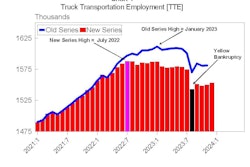
Selling a business is a pivotal and life-changing event. A business may represent the majority of a family’s net worth, and a sale is the last chance for that business to generate income for the family. Although the process is not difficult, it is highly complex.
Add to that, the psychological and emotional aspect of selling a family business, the concern if employees and customers will be treated with the same care and respect, and the unfamiliarity with the buy-sell process. It is imperative that a sale be handled with care and diligence by experienced professionals.
Performance Brokerage Services is the highest volume dealership brokerage firm in North America, having consummated 84 dealership sales in 2023. Our 10 steps below are a high-elevation outline of the buy-sell process for a traditional asset sale. It is intended to help dealers maximize the value of their business, accomplish your goals and minimize pitfalls.
Going backwards to start
As a first step, take a step back. Before any action is taken, identify and assess your personal and business goals. What would an ideal sale look like for you, your family, team, community, manufacturers, and suppliers? This is critical in determining to what extent the offer and specific buyer will accomplish your goals.
1. Assemble your selling team
We always advise our clients to surround themselves with a team of their trusted advisors. This helps ensure that your best interests are protected, while you continue to focus on the day-to-day operations and maximizing the dealership’s performance. Your team should include your attorney, accountant, financial planner and dealership broker. Each professional has a particular role in the process, and it is imperative that members of your team have experience in dealership transactions.
2. Information gathering
Provide the buyer with sufficient information to properly evaluate the opportunity, build a proforma or projection of earnings, and submit to you an offer that is well-informed of the relevant facts. A typical request includes information regarding financial data, assets and inventories (including lease fleet details), real estate, manufacturers and vehicle sales, contracts to be assumed, and your organization. By demonstrating you are organized, prepared and willing to share information, you will increase the buyer’s confidence that engaging with you will be a smooth transaction. Remember, active and seasoned buyers are regularly evaluating acquisition opportunities, and often more than one at any given time.
[RELATED: Service shop in eastern U.S. available for purchase]
When working with a dealership broker, all the information should be packaged into a Confidential Information Memorandum and disseminated only after securing from the buyer a signed Non-Disclosure Agreement (NDA).
3. Marketing strategy
Prepare a custom-tailored marketing strategy that accomplishes your unique goals. An ideal sale may be price driven, though it may also include identifying a buyer whose values closely align with yours, who prefers to lease the real estate, who will exclude your family from your non-compete clause, etc. Also consider the number of disclosures required to reach those goals, as the higher number of disclosures, the higher likelihood for a confidentiality breach.
4. Buyer filtration
The buy-sell process is lengthy, overwhelming, intimate, and requires a certain level of trust and respect between the principals. There will be many opportunities for a buyer to attempt to renegotiate or “re-trade” the deal after you have given up leverage. A confidentiality breach early in the process can cause harm to your business. Not all buyers have the financial wherewithal and operational experience to secure a floorplan and agreements from the manufacturers. Therefore, filter your prospective buyers, rely on your advisory team and do not ignore red flags.
5. Letter of Intent
Also referred to as an “LOI”, this non-binding agreement outlines the major components of the transaction as agreed upon between buyer and seller. We prepare a highly detailed LOI so it serves as a framework for the attorneys to draft the definitive agreements. It is important to note that certain items in the LOI are in fact binding like the Confidentiality and Exclusivity provisions.
[RELATED: ATD webinar to answer 'How much is your dealership worth?']
Even if the goodwill amount is the same, not all offers are created equal. Be sure to perform a total deal review, evaluating the various terms of the LOI as well as the profile of the buyer and consider how each LOI/buyer may accomplish your unique goals. The buyer who ends up closing on the transaction, may not necessarily be the buyer who offers the most money, but instead is the best overall buyer.
6. Definitive agreements
Expanding upon the LOI, the attorneys will prepare the Definitive Agreements, including an Asset Purchase Agreement (APA) and a Real Estate Purchase Agreement (REPA or RESPA) or Lease Agreement. Since the terms are binding and enforceable, and to ensure the agreements are fair and equitable for both sides, this requires multiple rounds of revisions between the attorneys. By utilizing a comprehensive LOI and remaining involved in the negotiations, you will expedite this step.
7. Due diligence period
The due diligence period may commence after mutually executing the LOI, or the definitive agreements. You may also elect for a hybrid where some less invasive due diligence items occur after the LOI is executed, while those more invasive only after the definitive agreements are executed. During this time, buyer will be granted the right to inspect the books and records, assets, inventories, real property and facility, contracts to be assumed, etc. Certain documents will be ordered like an appraisal, environmental study, building inspection, surveys, title reports, etc.
Despite your heavy involvement in the due diligence, do not let it distract from your dealership operation. Maintain strict control over your business and maximize its performance. Do not take your foot off the gas!
[RELATED: Enter the Year of the Dragon in the M&A space]
8. Manufacturer approval
Upon completion of the due diligence, you will notify the manufacturers of your intent to sell. Your attorney may also submit a letter to the manufacturers authorizing them to communicate with your buyer.
Following buyer’s approval by the manufacturers, you would then inform your employees and introduce the buyer, allowing buyer to share the company culture, philosophies, systems and alike.
9. Closing
Although not necessary, you may choose to close the dealership for a day while you finalize the sale and the closing tasks. In part, this will include final inventory adjustments, employee hiring, system integrations, contract and utility assumptions, removing excluded assets from the premises, signing escrow documents, securing lien releases, transferring funds, etc.
10. Post-closing
Congratulations, you may finally exhale as the deal is closed! As an asset sale, certain items will remain your responsibility post-closing, including satisfying accounts payable, collecting receivables, managing the service and F&I chargebacks, and relocating business records that need to be maintained.
Reducing a highly complex process and the culmination of one’s life work into this article only scratches the surface. So, a few key comments that may help you reach your destination: your advisory team is invaluable, preparation is paramount, patience, diligence, and vigilance are essential, respect and transparency promote good faith negotiations, always keep your eyes on the prize, and keep running your business likes it’s not for sale.










